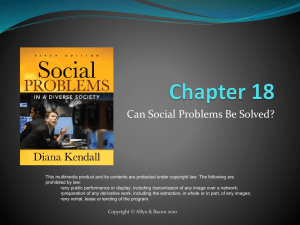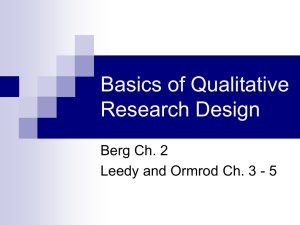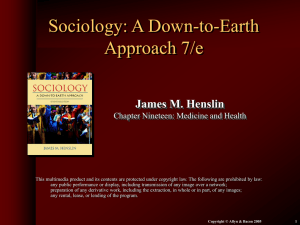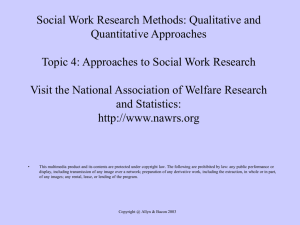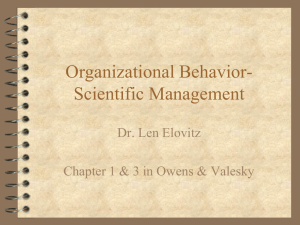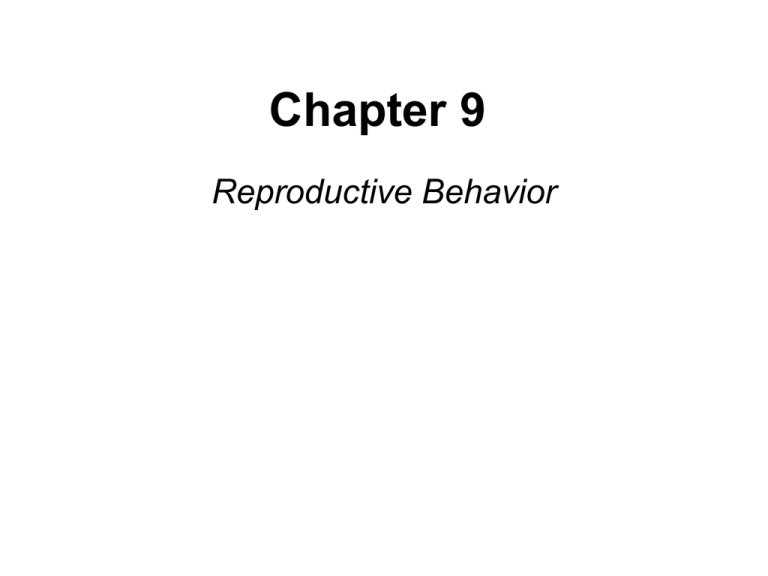
Chapter 9
Reproductive Behavior
This multimedia product and its contents are protected under copyright
law. The following are prohibited by law:
•any public performance or display, including transmission of any image
over a network
•preparation of any derivative work, including the extraction, in whole or
in part, of any images
•any rental, lease or lending of the program.
1
Copyright © 2008 Pearson Allyn & Bacon Inc.
• Chapter 9 Outline
• Sexual Development
• Hormonal Control of Sexual Behavior
• Neural Control of Sexual Behavior
• Parental Behavior
2
Copyright © 2008 Pearson Allyn & Bacon Inc.
• Sexual Development
• Sexually _________________behavior
• A behavior that has different forms or that occurs with
different probabilities or under different circumstances
in _____________________.
Courting behavior
Mating behavior
Parental behavior
Aggression
3
Copyright © 2008 Pearson Allyn & Bacon Inc.
• Sexual Development
• Sexual development
• ______________:
• A mature reproductive cell; a sperm or ovum.
• __________: contains one member of a pair of ___
chromosomes
• Sex chromosome:
• The X and Y chromosomes, which determine an
organism’s gender. Normally, females are XX and
males are XY.
4
Copyright © 2008 Pearson Allyn & Bacon Inc.
Gender is
determined
by the ___
chromosome
in the sperm.
5
Copyright © 2008 Pearson Allyn & Bacon Inc.
• Sexual Development
• Development of the sex organs
• __________
• An ovary or testis.
• ____
• The gene of the Y chromosome whose produce
instructs the undifferentiated fetal gonads to develop
into testes.
6
Copyright © 2008 Pearson Allyn & Bacon Inc.
• Natures impulse is to build a female body unless
instructed to do otherwise.
• Exposure to sex hormones _________________ is
responsible for sexual dimorphism.
• The immature gonad is capable of becoming female
(ovary) or male (testes).
7
Copyright © 2008 Pearson Allyn & Bacon Inc.
8
Copyright © 2008 Pearson Allyn & Bacon Inc.
• Sexual Development
• Development of the sex organs: hormomes
have both organizational and activational effects
• _____________effect (of hormone)
• The effect of a hormone on tissue differentiation and
development. These effects are ___________.
• ______________effect (of hormone)
• The effect of a hormone that occurs in the fully
developed organism; may depend on the organism’s
prior exposure to the organizational effects of
hormones.
9
Copyright © 2008 Pearson Allyn & Bacon Inc.
• Sexual Development
• Internal sex organs:
• The immature gonad has both a Müllerian and
Wolffian system
• _______________system
• The embryonic precursors of the female internal sex
organs.
• ________________system
• The embryonic precursors of the male internal sex
organs.
10
Copyright © 2008 Pearson Allyn & Bacon Inc.
• Sexual Development
• Internal sex organs
• Anti-Müllerian hormone
• A peptide secreted by the fetal testes that inhibits the
development of the Müllerian system, which would
otherwise become the ________________________.
• Defeminizing effect
• An effect of a hormone present early in development
that reduces or prevents the later development of
anatomical or behavioral characteristics typical of
females.
11
Copyright © 2008 Pearson Allyn & Bacon Inc.
• Sexual Development
• Internal sex organs
• _____________
• A male sex steroid hormone. Testosterone is the
principal mammalian androgen.
• _______________effect
• An effect of a hormone present early in development
that promotes the later development of anatomical or
behavioral characteristics typical of males.
• _______________
• The principal androgen found in males.
12
Copyright © 2008 Pearson Allyn & Bacon Inc.
• Sexual Development
• Internal Sex Organs
• Dihydrotestosterone
• An androgen, produced from testosterone through the
action of the enzyme 5 reductase.
• ____________________________
• A condition caused by a congenital lack of functioning
androgen receptors; in a person with XY sex
chromosomes, causes development of a female with
testes but no internal sex organs. The external genitalia
are _______________________________________.
13
Copyright © 2008 Pearson Allyn & Bacon Inc.
• Sexual Development
• Internal sex organs
• Persistent Müllerian duct syndrome
• A condition caused by a congenital lack of
anti-Müllerian hormone or receptors for this hormone;
in a male, causes development of
________________________________________.
The presence of the female anatomy disrupts the
functioning of the male anatomy.
• ___________________
• The presence of only one sex chromosome (X0);
characterized by lack of ovaries but otherwise normal
female sex organs and genitalia. (Usually the result of
a defective sperm.)
14
Copyright © 2008 Pearson Allyn & Bacon Inc.
15
Copyright © 2008 Pearson Allyn & Bacon Inc.
16
Copyright © 2008 Pearson Allyn & Bacon Inc.
• Sexual Development
• _______________: The onset of puberty is
governed by the hypothalamus by the initiation of
the secretion of gonadotropin-releasing hormone.
• _______________________________
A hypothalamic hormone that stimulates the anterior
pituitary gland to secrete gonadotropic hormone.
• ______________________hormone
• A hormone of the anterior pituitary gland that has a
stimulating effect on cells of the gonads.
17
Copyright © 2008 Pearson Allyn & Bacon Inc.
18
Copyright © 2008 Pearson Allyn & Bacon Inc.
• Sexual Development
• Sexual maturation (2 gonadotropic hormones are
secreted by the pituitary)
• _______________________
• The hormone of the anterior pituitary gland that
causes development of an ovarian follicle and the
maturation of it as an ovum.
• __________________
• A hormone of the anterior pituitary gland that causes
ovulation and development of the ovarian follicle into a
corpus luteum.
• In males these same hormones cause the
___________________________________________
19
Copyright © 2008 Pearson Allyn & Bacon Inc.
_
• Sexual Development
• Sexual maturation (Female)
• _______________
• The principal estrogen of many mammals, including
humans.
• ________________
• A class of sex hormones that causes maturation of the
female genitalia, growth of breast tissue, and
development of other physical features characteristic of
females.
20
Copyright © 2008 Pearson Allyn & Bacon Inc.
• Sexual Development
• Sexual maturation (Male)
• ____________________
• The principal androgen of many mammals, including
humans.
• ______________
• A class of sex hormones that causes maturation of the
male genitalia, growth of facial and body hair, lowering of
the voice, muscle development, and development of other
physical features characteristic of males.
21
Copyright © 2008 Pearson Allyn & Bacon Inc.
• Hormonal Control of Sexual Behavior
• Hormonal control of female reproductive cycles
• __________________
• The female reproductive cycle of most primates,
including humans, characterized by growth of the
lining of the uterus, ovulation, development of a
corpus luteum, and (if pregnancy does not occur)
menstruation.
22
Copyright © 2008 Pearson Allyn & Bacon Inc.
• Hormonal Control of Sexual Behavior
• Hormonal control of female reproductive cycles
• _________________
• The female reproductive cycle of mammals other than
primates.
• ___________________
• A cluster of epithelial cells surrounding an oocyte
which develops into an ovum.
23
Copyright © 2008 Pearson Allyn & Bacon Inc.
24
Copyright © 2008 Pearson Allyn & Bacon Inc.
• Hormonal Control of Sexual Behavior
• Hormonal control of female reproductive cycles
• Menstrual or estrus cycles
• ____________________
• A cluster of cells that develops from the ovarian follicle
after ovulation; secretes estradiol and progesterone.
• ______________________
• A steroid hormone produced by the ovary that
maintains the endometrial lining of the uterus during
the later part of the menstrual cycle and during
pregnancy.
25
Copyright © 2008 Pearson Allyn & Bacon Inc.
• FSH stimulates the growth of an ovarian follicle (a
sphere of cells surrounding each ovum).
• The follicle secretes estradoil which in turn causes the
pituitary to secrete LH.
• The surge in LH causes _____________.
• Following ovulation the ruptured follicle becomes the
corpus luteum which secretes progesterone and
estradiol which promote pregnancy.
26
Copyright © 2008 Pearson Allyn & Bacon Inc.
• Hormonal Control of Sexual Behavior of Laboratory
Animals
• Males
• Intromission, pelvic thrusting, ejaculation
• ________________
• A period of time after a particular action (for example,
an ejaculation by a male) during which that action
cannot occur again.
• ___________________
• The restorative effect of introducing a new female sex
partner to a male that has apparently become
“exhausted” by sexual activity.
27
Copyright © 2008 Pearson Allyn & Bacon Inc.
• Hormonal Control of Sexual Behavior of Laboratory
Animals
• Females
• ______________
• A sexual spinal reflex seen in many four-legged
animals. Female mammals; arching of the back in
response to approach of a male or to the touch of
the flanks, which elevates the hindquarters.
In the absence of this reflex intromission is no possible.
No recreational (non-reproductive) mating behavior.
28
Copyright © 2008 Pearson Allyn & Bacon Inc.
Castrated at birth
29
Copyright © 2008 Pearson Allyn & Bacon Inc.
• Organizational Effects of Androgens on Behavior:
Masculinization and Defeminization
• Effects of pheromones
• __________________
• A chemical released by one animal that affects the
behavior or physiology of another animal; usually
smelled or tasted.
• ____________________
• The slowing and eventual cessation of estrous cycles
in groups of female animals that are housed together;
caused by a pheromone in the animal’s urine.
30
Copyright © 2008 Pearson Allyn & Bacon Inc.
• Organizational Effects of Androgens on Behavior:
Masculinization and Defeminization
• Effects of pheromones
• ____________________
• The synchronization of the menstrual or estrous cycle
of a group of females, which occurs only in the
presence of a pheromone in a male’s urine.
• ________________________
• The earlier onset of puberty seen in female animals
that are housed with males; caused by a pheromone
in the male’s urine.
31
Copyright © 2008 Pearson Allyn & Bacon Inc.
• Organizational Effects of Androgens on Behavior:
Masculinization and Defeminization
• Effects of Pheromones
• ___________________
• Termination of pregnancy caused by the odor of a
pheromone in the urine of a male other than the one
that impregnated the female.
• _________________________
• A sensory organ that detects the presence of certain
chemicals, especially when a liquid is actively sniffed;
mediates the effects of some pheromones.
32
Copyright © 2008 Pearson Allyn & Bacon Inc.
• Organizational Effects of Androgens on Behavior:
Masculinization and Defeminization
• Effects of pheromones
• ____________________
• A neural structure located in the main olfactory bulb
that receives information from the vomeronasal organ.
33
Copyright © 2008 Pearson Allyn & Bacon Inc.
• Pheromones in humans
•
•
•
•
Menstrual synchronization
Essence of Genieve
May function to ____________________
Androstadienone (AND) in male sweat induces
alertness and _________________in women, but
not in men. Could play a role in bonding, mate
attraction and mate recognition.
34
Copyright © 2008 Pearson Allyn & Bacon Inc.
35
Copyright © 2008 Pearson Allyn & Bacon Inc.
Female initiation promotes conception
36
Copyright © 2008 Pearson Allyn & Bacon Inc.
• Neural Control of Sexual Behavior
• Prenatal androgenization of genetic females
• _______________________________ (CAH)
• A condition characterized by hypersecretion of
androgens by the adrenal gland; in females, causes
masculinization of the external genitalia.
• Increase in bisexual and homosexual orientation.
• Increase play with male-typical toys.
37
Copyright © 2008 Pearson Allyn & Bacon Inc.
Sexual Orientation
Sexual orientation refers to a person’s preference for
emotional and sexual relationships with individuals of the
same sex, other sex and/or either sex; an enduring
sexual attraction toward members of either one’s own
gender (homosexual orientation) or the other gender
(heterosexual orientation)
Homosexual
Heterosexual
Revision
2006 PSB
Bisexual
Sexual Preference
• About 4% of the adult population is
•
homosexual – sexual behavior is directed
towards members of one’s own gender.
Neuronal factors: LeVay (1991) found that
one region of the hypothalamus was two
times larger in hetersexual males compared
to that for homosexual males. In male
monkeys the surgical destruction of these
cells reduced the monkeys interest in
females, but did not reduce _____________.
Revision
2006 PSB
Sexual Motivation
Origins of Homosexuality
• Identical twins have highest concordance (similarity)
•
rates for sexual orientation compared to fraternal twins
and adoptive siblings.
• Same pattern exists for males and females.
This suggests that sexual orientation is influenced by
genes.
Revision
2006 PSB
Bailey & Pillard (1991; 1992)
• Male homosexuality concordance rates:
52% identical twin
22% fraternal twin
11% adopted brother
Female homosexuality concordance rates:
48% identical twin
16% fraternal twin
6% adopted sister
Revision
2006 PSB
Origins of Sexual Orientation
Homosexuality is more likely to be based on
biological factors like differing brain centers,
genetics, parental hormone exposure, than
_________________________________.
Cynthia Johnson/ Time magazine
Homosexual parents
Revision 2006 PSB
The Homosexual Man’s Brain
The size of the anterior hypothalamus is smaller
(LeVay, 1991) and anterior commissure is larger
(Allen & Gorski, 1992) in homosexual men.
http://www.msu.edu
Anterior
Commissure
Anterior
Hypothalamus
Revision 2006 PSB
Hormones & Sexual Orientation
Prenatal hormones affect sexual orientation
during _______________ of fetal development.
1.
2.
Animals: Testosterone exposure to fetus results in
females (sheep) showing homosexual behavior.
Humans: Female hormone exposure to male or
female fetus (human) results in attraction to males.
Heterosexual
male
Homosexual
Revision
2006 PSB
Heterosexual
female
Sexual Orientation
• Recent data suggests that male
homosexuality is more common among the
male relatives of the men’s _________
side of the family. The gene for sexual
orientation is located on the x chromosome
– the only chromosome inherited
exclusively from one’s __________.
• Area Xq28 is believe to most strongly
influence sexual orientation.
Revision
2006 PSB
Changing Attitudes
Revision
2006 PSB
47
Copyright © 2008 Pearson Allyn & Bacon Inc.
• Neural Control of Sexual Behavior
• Males
• ___________________ (MPA)
• An area of cell bodies just rostral to the hypothalamus;
plays an essential role in male sexual behavior.
48
Copyright © 2008 Pearson Allyn & Bacon Inc.
• Neural Control of Sexual Behavior
• Males
• Sexually dimorphic nucleus (SDN)
• A nucleus in the preoptic area that is much larger in
males than in females; first observed in rats; plays a
role in male sexual behavior.
• The size of this nucleus appears to depend on
________________________________________.
49
Copyright © 2008 Pearson Allyn & Bacon Inc.
• Neural Control of Sexual Behavior
• Males
• Nucleus paragigantocellularis (PGi)
• A nucleus of the medulla that receives input from the
medial preoptic area and contains neurons whose
axons form synapses with motor neurons in the spinal
cord that participate in sexual reflexes in males.
• The PGi inhibits sexual reflexes by releasing serotonin
on spinal nuclei. The MPA pathway must act to
suppress PGi inhibition for sexual reflexes to occur.
• SSRI drugs emulate PGi inhibition and depress
________________.
50
Copyright © 2008 Pearson Allyn & Bacon Inc.
51
Copyright © 2008 Pearson Allyn & Bacon Inc.
52
Copyright © 2008 Pearson Allyn & Bacon Inc.
• Neural Control of Sexual Behavior
• Females
• ____________________________________(VMH)
• A large nucleus of the hypothalamus located near the
walls of the third ventricle; plays an essential role in
female sexual behavior.
53
Copyright © 2008 Pearson Allyn & Bacon Inc.
54
Copyright © 2008 Pearson Allyn & Bacon Inc.
55
Copyright © 2008 Pearson Allyn & Bacon Inc.
• Pair bonding
• Increase levels of vasopressin and oxytocin are
observed in_____________, relative to polygynous
ones, and injections of vasopressin can transform
polygynous rodents into _____________pair bonding.
• Biologically fitness is determined by procreation, and
•
parental behavior is critical for reproductive success.
Maternal behavior is established by a hormonal
sequence associated with reproduction.
56
Copyright © 2008 Pearson Allyn & Bacon Inc.
57
Copyright © 2008 Pearson Allyn & Bacon Inc.
• Virgin females injected with hormones that duplicates
this sequence will rapidly begin to display maternal
care for pups.
• Pair bonding between mother and offspring appear to
involve ___________________.
• fMRI studies show that when mothers are shown
photos of their infants that brain centers that contain
receptor sites for vasopressin and oxytocin are
activated, as well as brain regions involved in
________________.
58
Copyright © 2008 Pearson Allyn & Bacon Inc.
• Summary
• Male and female behaviors are not simply the result
of socialization.
• The case of Brenda described by Carlson suggests
that the infant’s brain was masculinized by early
exposure to androgens and Brenda was unable to
adjust to the female body and role expectations that
had been surgically and chemically constructed for
her.
59
Copyright © 2008 Pearson Allyn & Bacon Inc.






